When you come to Southwest Ireland, you are overawed by the stunning mountains, green valleys and shining water. But there’s another facet to life here you just can’t ignore – the weather.
Specifically, the wind.
Oh, the Irish rain is legendary, of course – soft and gentle, watering the land to a brilliant green that sings out like a Hallelujah.
Or pouring from indigo clouds like the original Deluge, pounding the dirt into a sponge that squelches underfoot and collects in new lakes; rushing down the lanes; breaking branches and stems with a violence that crashes around your ears like all the Angels of the Apocalypse were galloping around you as you cower beneath raindrops as big and hard as golfball hailstones (and often are).
Sure, it’s not the cyclones of Bangladesh or the blizzards of Fairbanks, but the winter weather of Ireland is as capricious as a toddler, quite often going from hail to sunshine to pouring rain in just a few minutes – or all at the same time.
But it’s the wind down here in the Southwest that defines the outdoor life. It’s an entity all of its own – so much so that it features in numerous folk tales and even in place names.
Wintry weather over Dingle Bay (Lynn Parr)
At this time of year, late Winter-early Spring, almost anything can happen here, weather-wise. One minute the wind is galloping and skipping over meadow grasses like silver horses, running in tandem with the foam stallions glimpsed between the hills, leaping from the grey water of Dingle Bay.
Next minute, the wind picks up and begins roaring and rolling round the house, bending trees, whipping spindly hawthorn branches, plucking tall grasses and sticks like strings. Petulantly, it flings handfuls of hail at the windows. Sleet and hail pour over the lip of the mountain behind us and fill up the saddle with white like a cup being filled with milk.
The rain intensifies until the mountains are streaked with silver trails and the streams roar down the ditches, clattering the stones and clambering over the rocky outcrops shouting.
But wait awhile, and everything changes.
When it’s all over, the rain has intensified the colours of the mountains, washing them clean of haze and dust, polishing rock and shrub so they glint in flashes of sunlight. On the opposite shore of Dingle Bay, the rocky cliffs of the Iveragh Peninsula wink like scattered diamonds where the sun gleams on wet rock.
And we forget what it was like ten minutes ago.
The goddess who controls the weather is traditionally said to be the Cailleach, the manifestation of Autumn and Winter. She is the opposite (or the other face) of Brigid, who looks after the Spring and Summer. She appears in folklore across the Celtic lands.
In Scotland, one tale has her washing her plaid (a tartan shawl worn over the shoulder) in the Corryvreckan whirlpool, which causes the water to boil and swirl. Another has her falling asleep after a long day herding deer on Ben Cruachan and letting a well she was tending overflow to flood the valley below and create the huge Loch Awe.
In Ireland, on the Beara Peninsula, the next one south of the Iveragh (Ring of Kerry), she had an altercation with a Christian saint who turned her into a large stone, which can still be seen today – though in other places, she is said to only become stone during the warmer months, until it’s her time to emerge and rule the land with Winter again.
Storm in Dingle Bay, seen from Cinn Aird (Lynn Parr)
Like most places, Winter can be harsh, particularly on livestock. Lambs always seem to pop out just before appalling weather. March in Irish is Earrach Geamraidh, the Winter Spring. The last three days of March are known as the Borrowed Days. According to one old tale, a brindled cow, the Bó Riabhach, boasted she could outsmart winter, but March borrowed three days from the beginning of April and unleashed violent winds and bitter weather. She was happy to have survived, but then discovered it was still only March, so she lost heart and died.
Yet even in April (the “cruellest month”, according to TS Eliot), weather and temperature can be deadly, especially for new lambs and calves, and newly blooming Spring flowers. The wind in late April/early May is known as the Scariveen (An Gaoth Scairbhín), the wind at the time of the cuckoo.
Strickeen with a dusting of snow – or hail (Lynn Parr)
In a 10th century collection of devotional poems, the Saltair na Rann, there are said to be twelve winds blowing from all the different directions (North, East, South and West, plus the degrees in-between), each of which has a colour. North is black, South is white, and the other colours range from speckled to dun, red to grey.
Here just outside Dingle, we are caught in-between the black norther roaring over the saddle beside Strickeen mountain and the grey-green southwest wind that hurtles up from Dingle Bay, bringing salt spray and Atlantic rain. Some years, it’s a wonder that any plant, tree or house survives these wild storms. Wind speeds close to 100 miles an hour are quite common in the Winter, particularly in the more exposed coastal areas.
Part of the unsettling feeling it brings it is the noise, as it roars around the eaves and thrums the power lines. Would we even hear it if it didn’t collide with solid things on its charge across the land? Would it just be a rushing in our ears as it passed?
Storm Over Ballinskelligs, oil on canvas, 91 x 61cm – Lynn Parr
Perhaps the worst wind storm in history occurred on the night of January 6-7, 1839. Known as the Big Wind, Óiche na Gaoithe Móire, it devastated the country from top to bottom, destroying buildings, livestock and trees. Newspapers all over Ireland reported extensive damage, often from the fires that started as chimneys were blown down and thatch caught alight. In Limerick alone, there was £20,000 worth of damage to buildings plus £30,000 damage to ships in port.
Herrings were swept six miles from the sea, and a Stormy Petrol – a bird of the deep ocean – was found 90 miles inland. Every village and town suffered in the hurricane, and many were wiped out completely, particularly in the poorer western areas, where cottages were built of mud-brick and thatch. It’s even thought that the Big Wind contributed to much of the emigration that happened around that time – beginning the process of emptying the West that the Great Famine of six years later continued. Since the storm happened on a Monday, the Gaelic Day of Judgment, some people – for example in Ventry, just west of Dingle – thought it was God’s punishment for those losing their faith.
The wind is such a character in the Irish psyche that it has given rise to many place names across the country in the vernacular Irish. For example, there’s Wind Gap (Bearna na Gaoithe) in County Waterford; Gweesalia (the sea wind) in County Mayo; and Tonlegee (Tóin le Gaoith) in County Galway (and Wicklow and Cavan), usually translated as meaning a hill with its back to the wind.
Trees near the coast are a distinctive shape. These ones near Dingle seem to be ignoring the signs. (Lynn Parr)
Well, it’s mid-March, and the sun is rising higher with a hen’s step every morning. Walking down the sunny lane with the sea gleaming on the horizon, suddenly we are patted then pelted with rain that roars across the land, blackening the blue sky and driving splinters of silver into the ground. We try and hug the tall bank and hedge – our little dog snuggles into the foot of the bank and refuses to go further – but there is no real shelter with no leaves in the hedges.
But then a double rainbow arches over Strickeen, framing blue sky once more as the storm gallops on by, leaving us and the land dripping.
There’s no getting away from it – and you are usually wearing the wrong clothes. So, rather than keep moaning, it’s best to just get on with life, regardless.
We’ve decided to call it exciting.




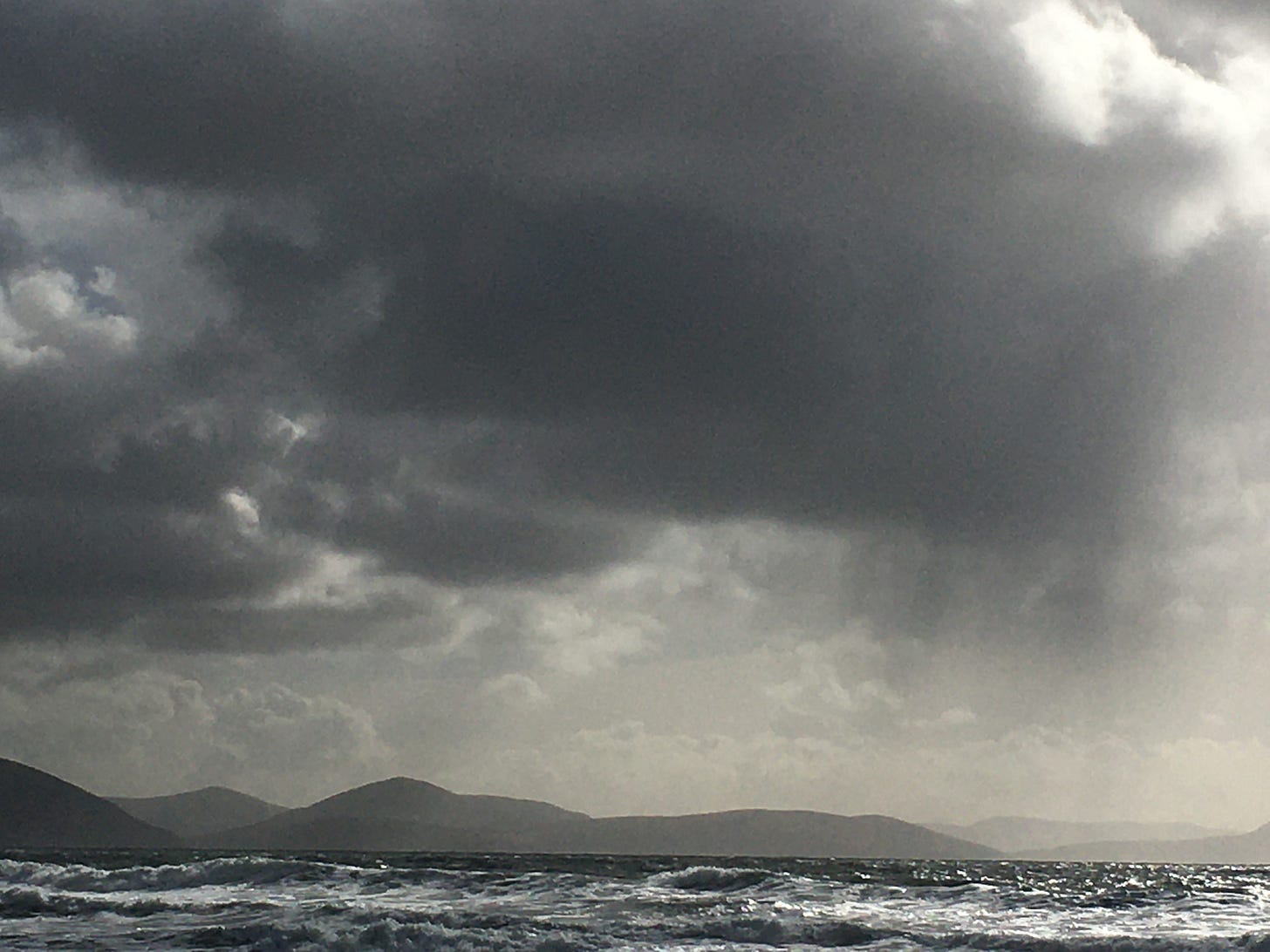
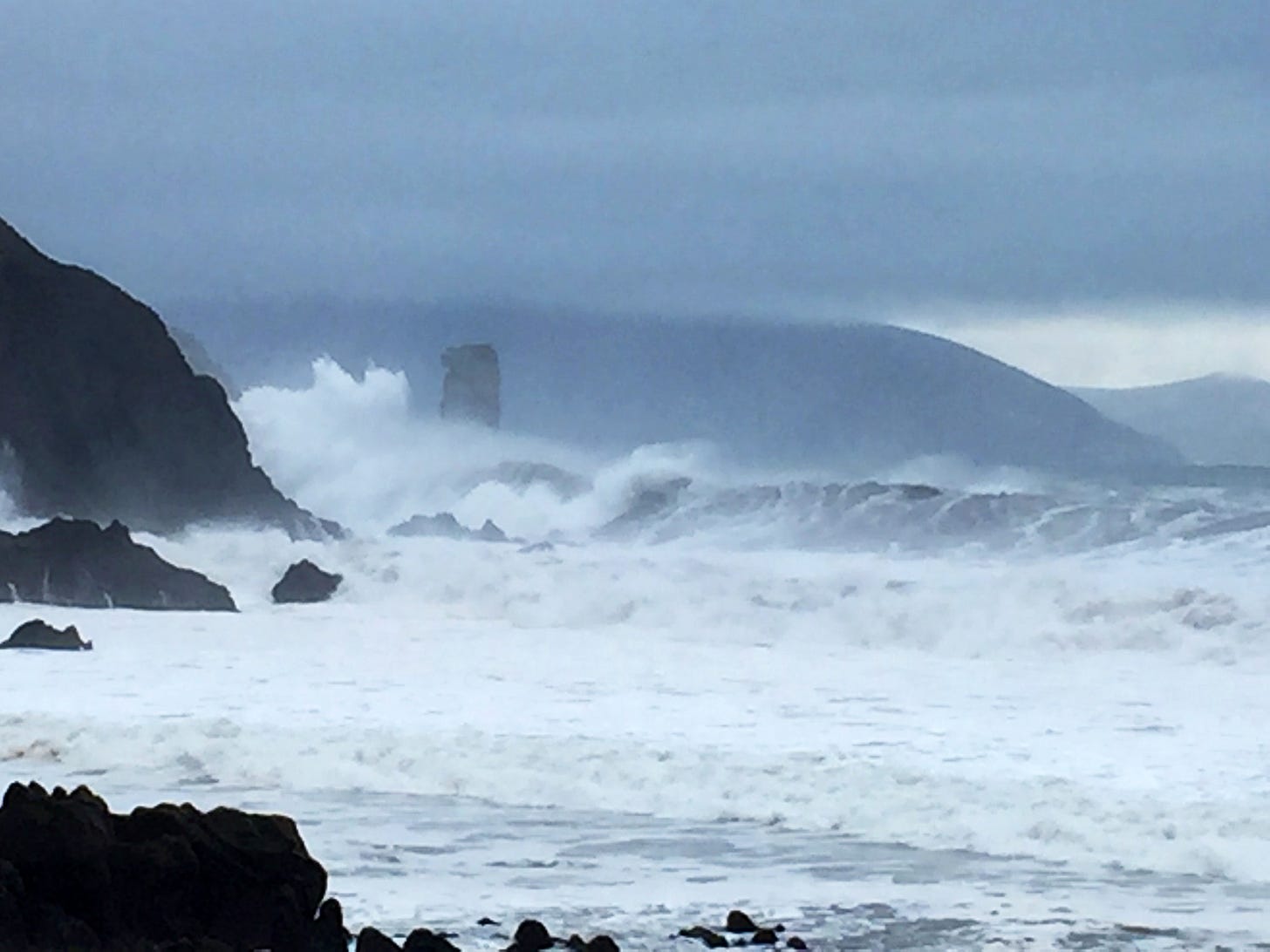
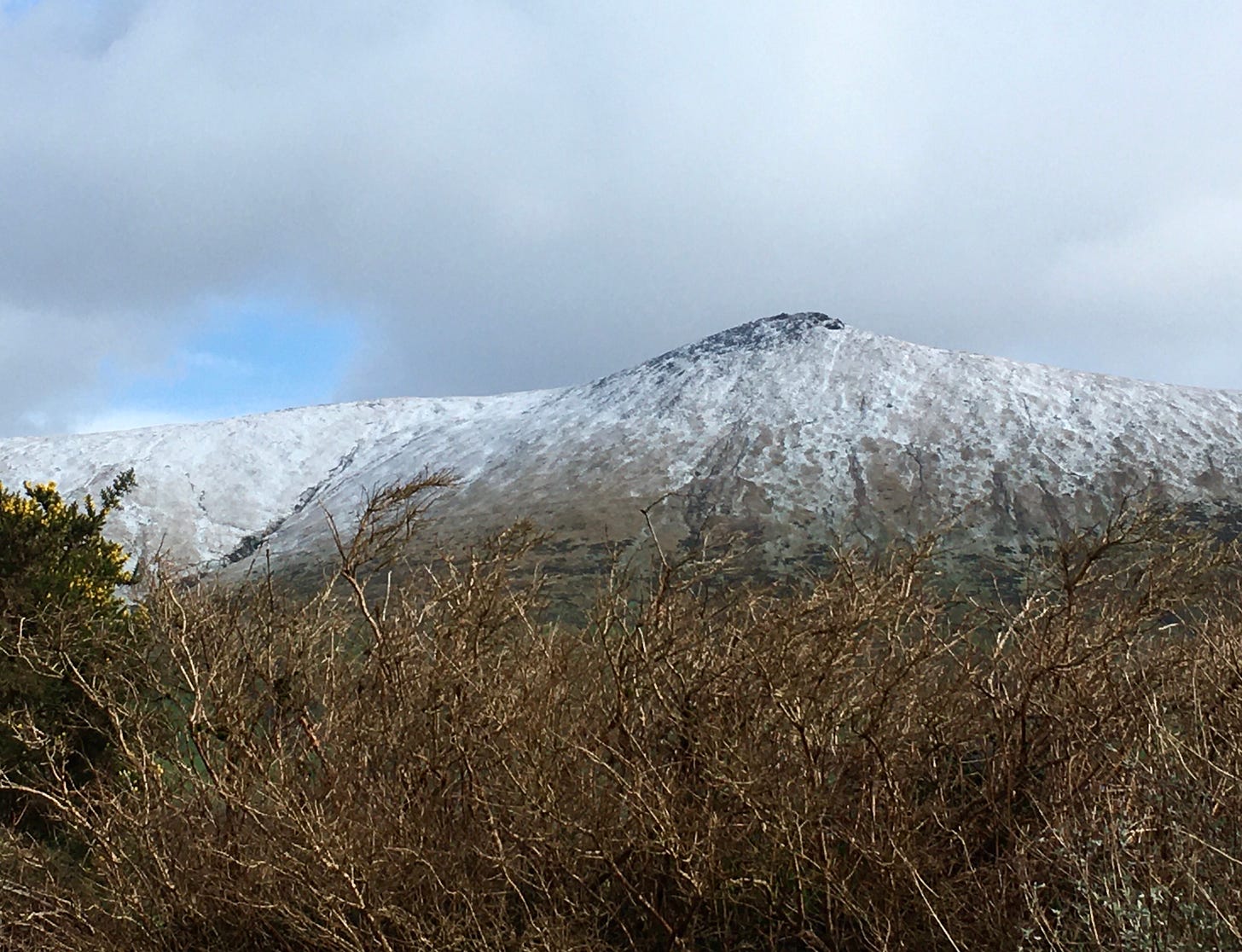
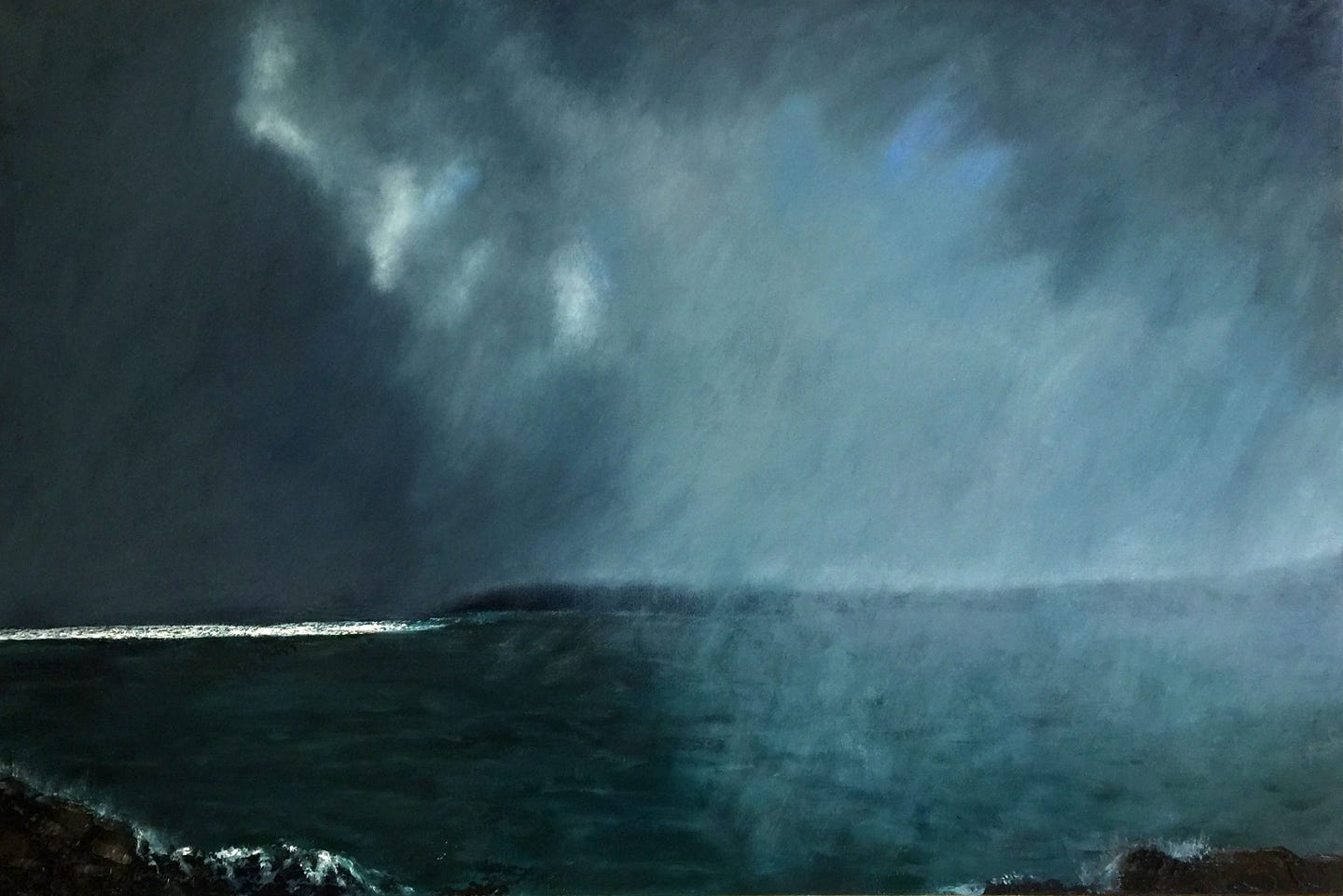
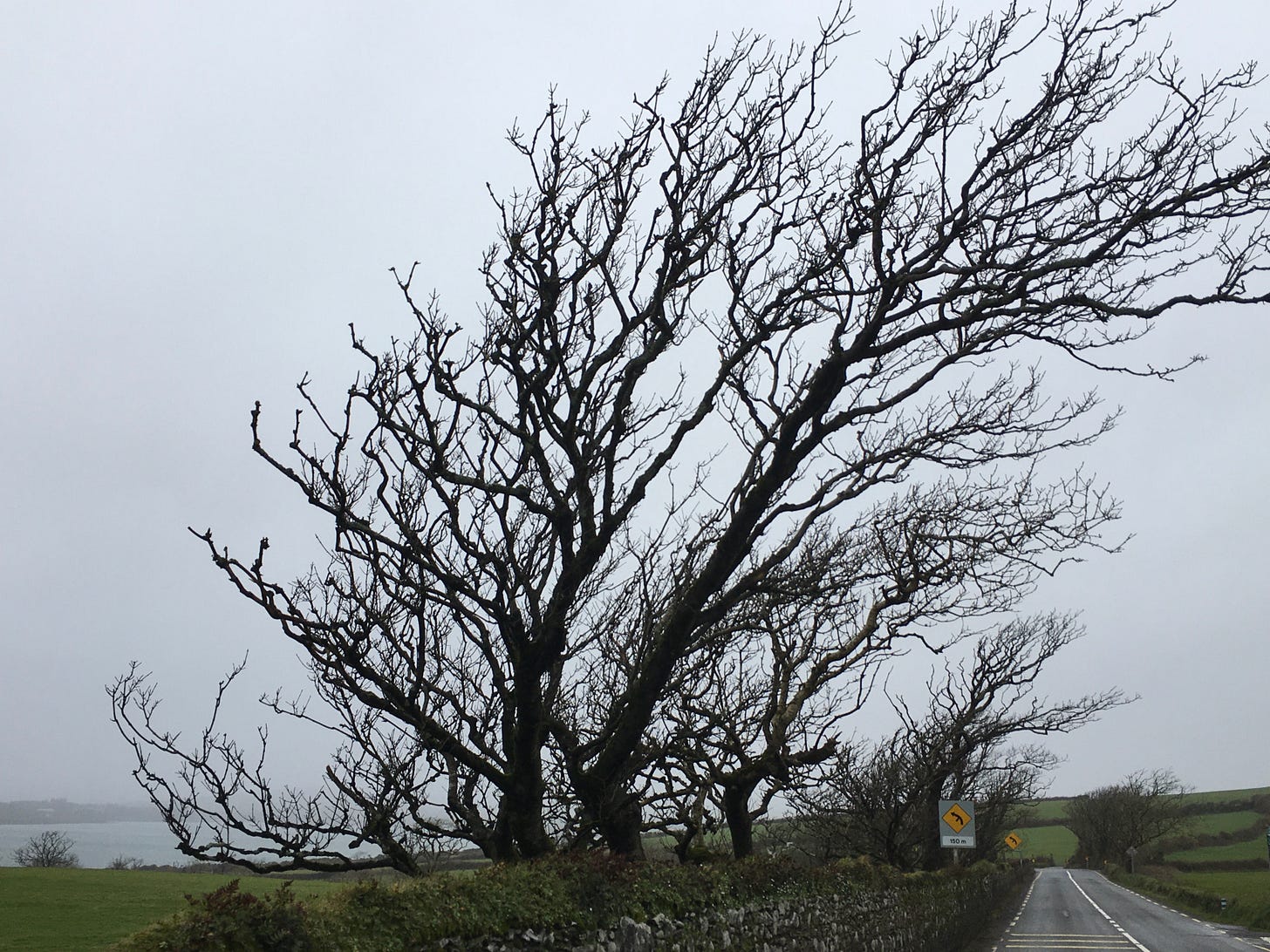
Very evocative writing which seems to capture the threads of time and place and weaves them into a thing of beauty....thank you for your insightful works